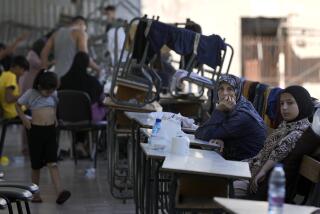Bleak Camp a Showcase by Default: It Has Food
- Share via
NARUS, Sudan — There used to be a nice water hole here. It was just right for the occasional elephant, dik-dik or nomad who needed a drink after wandering in the blast-furnace heat of the acacia plains.
Since March, however, about 20,000 refugees from Sudan’s civil war have drunk from the water hole. It is now a pit of jet-black mud.
But the Toposa nomads who have come here in retreat from fighting and famine are still thirsty. So every morning, hundreds of lanky Toposa, most of them naked but for jewelry in their ears and lower lips, take Red Cross shovels and big steel pots out to the pit. There, in gooey muck up to their elbows, they cull a few gallons of brackish drinking water.
“It is quite possible that it will all dry up and there won’t be any more water,” Henriett Subilia, a Red Cross nurse here, said. She said that the water table beneath the camp is falling weekly.
In southern Sudan, where about 2 million people are at risk of starvation due to war, famine and a blockade on international relief aid, this desert feeding center with its waning water hole is, by default, a humanitarian showcase.
Since it is tucked away in a rebel-held southeastern corner of Sudan, near the Kenyan border and well away from fighting between rebel and government soldiers, Narus boasts what no other camp, town or city in southern Sudan has: a regular supply of relief food.
Red Cross food is trucked in 29 miles from Kenya. The neatly uniformed, well-armed, well-fed soldiers of the Sudanese People’s Liberation Army (SPLA) who are encamped here beside the destitute nomads have no objection to the Red Cross food.
Shot Down Airliner
It is all right, they say, because there is no way that it can pass from Narus into the hands of Sudanese government soldiers. It is when such relief food goes near government-held towns--where United Nations officials say tens of thousands of civilians are starving--that the rebel commander here says that international assistance is not all right.
The rebels shot down a civilian airliner in August, killing 60 people, when it violated their ban on all aircraft in southern Sudan. The commander said that rebels will shoot down any relief plane that goes near the government-held towns.
“Narus is an example of the SPLA’s ability to do the job,” said Lt. Col. Martin Manyiel, the rebel commander in this region. “We don’t have any trust that aid administered through the Sudanese government will do very well.”
Narus is also an example of the wretched choices that war and famine have offered southern Sudanese peoples like the Toposa.
They can stay here near the Red Cross food and squeeze water out of mud. Or they can walk off to other water holes away from the Kenyan border--and away from the Red Cross food.
Crops Burned
If their crops had not been burned and if their cattle not been stolen in the war, Toposa nomads would never have come here in such numbers to drink dry the water hole. Instead, according to Toposa Chief Lucia Lapua, who leads about 7,000 of the nomads, they would be on the move with their cattle, collecting the berries and nuts that ripen on desert trees this time of year. The Toposa have never before settled in a camp to receive relief food, the chief said.
Red Cross doctors and nurses here say that the nomads have not adapted well to the routines of food distribution and medical care. A measles epidemic claimed the lives of 135 children under age 5 in the camp’s feeding center this summer.
“The feeding center doesn’t work well because the Toposa take their children away all the time,” nurse Subilia said. “We had 450 children registered one day and the next day there were 150.”
Subilia, who cared for malnourished children at famine camps in Ethiopia in 1984 and 1985, said that about 13 of the children in Narus are severely malnourished. That figure, she said, squares with the usual percentage at the height of Ethiopia’s famine.
“But unlike Ethiopia, we don’t have to choose here between what children to care for and what children are beyond help,” she said. “Here, the nomads make that choice themselves.
Half-Dead Children
“In the back of huts around the camp, you will find half-dead children. Once they get sick, the parents believe they shouldn’t have milk or sugar, fat or oil. We can’t go every day and pull the children from their mothers.”
Red Cross officials are unsure about the future of Narus. If the camp runs out of water, they say they will have to feed people somewhere else.
Brigitte Meng, a Red Cross official who visited here recently, described this camp as “a drop in an ocean.”
More to Read
Sign up for Essential California
The most important California stories and recommendations in your inbox every morning.
You may occasionally receive promotional content from the Los Angeles Times.










